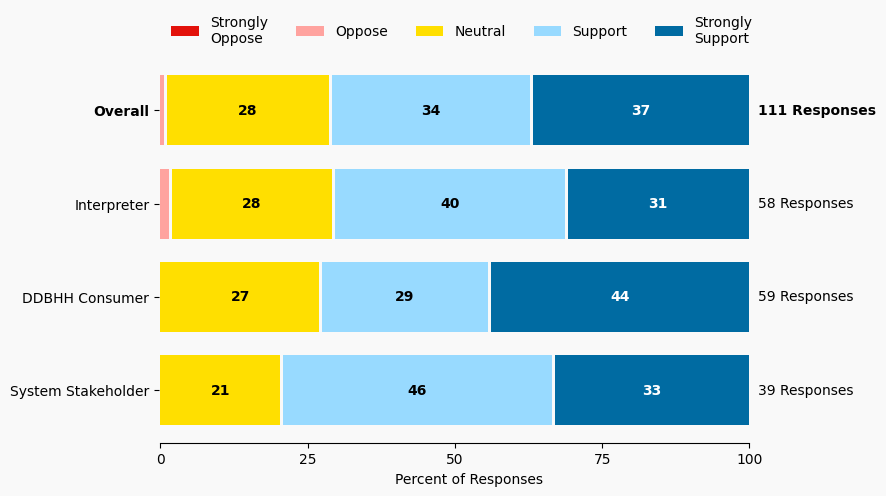75 Advocate for Health Care Systems to Develop Welcome Packets
Issue: Consumers need more information about resources in health care systems
Proposed Solution: Minnesota Department of Health and Department of Human Services, Deaf, DeafBlind and Hard of Hearing State Services leading, in partnership with the Minnesota Hospital Consortium, will guide the development of welcome packets for each healthcare system. Welcome packets could include: Contact list of healthcare systems interpreting offices and patient care advocates ASL versions of patient self-advocacy supports available in health care how their interpreting system works how to register a complaint, including examples of valid complaints and complaints that are outside of scope for the healthcare system to address how to access legal resources and how to make formal complaints
Expected outcome: DDBHH patients will experience better health outcomes as their ability to advocate for their communication access increases. This solution, in conjunction with 2 DSAT Training for Self-Advocacy and 82 Promote Community Health Workers for Healthcare Settings, is expected to have a significant impact on health outcomes due to increased self-efficacy of DDBHH people in their healthcare.
Who is impacted: Consumers in health care settings, health care systems, interpreters
Timeline: 6 months

Summary of Support Image Description
The stacked bar charts show how respondents rated their level of support and the total number of responses. The percentage for the five support levels is shown from left to right: Strongly Oppose (Dark Red), Oppose (Light Red), Neutral (Yellow), Support (Light Blue), and Strongly Support (Dark Blue).
Respondents may identify with multiple subgroups. The overall level of support is:
Overall
Strongly Oppose: 0%
Oppose: 1%
Neutral: 28%
Support: 34%
Strongly Support: 37%
Click to see the detailed image description for each subgroup.
Interpreter
Strongly Oppose: 0%
Oppose: 2%
Neutral: 28%
Support: 40%
Strongly Support: 31%
DDBHH Consumer
Strongly Oppose: 0%
Oppose: 0%
Neutral: 27%
Support: 28%
Strongly Support: 44%
System Stakeholder
Strongly Oppose: 0%
Oppose: 0%
Neutral: 21%
Support: 46%
Strongly Support: 33%
Overview of Respondents Opting for In-Depth Solution Analysis
After indicating their support level, 1% of the 111 respondents opted in to further assess whether the solution would worsen or improve on five metrics. Of the opt-in reviewers (2 respondents), 50% supported the solution, 50% were neutral on the solution, and 0% opposed the solution.
The remaining 109 respondents did not opt in to further assess the solution. Of these people, 71% support the solution, 27% were neutral on the solution, and 0% opposed the solution.
Reviewer Evaluation of Solution Effectiveness

Solution Effectiveness Image Description
The stacked bar charts show how respondents assessed the effectiveness of this solution based on five metrics. For each metric, the percentage of respondents is shown from left to right: Worsens (Red), Improves (Blue), No Impact (Gray).
DDBHH Quality of Life
Makes It Worse 0%
Makes It Better 100%
No Impact 0%
Interpreter Satisfaction
Makes It Worse 0%
Makes It Better 83%
No Impact 16%
Consumer Choice
Makes It Worse 0%
Makes It Better 83%
No Impact 16%
Interpreting Availability
Makes It Worse 0%
Makes It Better 80%
No Impact 20%
Interpreting Quality
Makes It Worse 0%
Makes It Better 60%
No Impact 40%
Reviewer Feedback and Insights
Interpreter
Comments from Interpreters suggests that healthcare documents currently translated into other languages should also be made accessible in ASL. Another comment supports the welcome packet idea, emphasizing that it could reduce the burden on healthcare interpreters who currently spend time educating consumers.
Deaf, DeafBlind, Hard of Hearing
No comments were submitted.
System Stakeholder
Comments from System stakeholders express concerns about the limited impact of a welcome packet, stating that healthcare systems should improve patient advocacy and awareness of Deaf community needs, as current processes fail to facilitate quick and easy decision-making participation for Deaf patients.
PREVIOUS SOLUTION
74 Advocate for Legislative Limits and Standards for K12 Interpreting Services
Issue: K12 educational interpreter standards are not closely regulated; DDBHH students suffer when placed in mainstream settings with no interpreter or an unqualified interpreter. Current job requirements, oversight, compensation and other crucial areas for ensuring highly qualified and valued interpreters for DDBHH youth are insufficient. Educational interpreters have great concerns and desire for more standards and support.
NEXT SOLUTION
76 Encourage More ASL-Fluent Mental Health Professionals for Direct Access to Mental Health Services
Issue: Consumers do not have enough access to interpreters for mental health services.
Leave a Reply